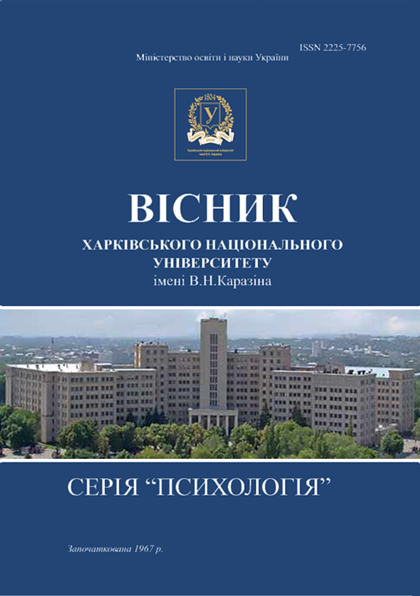THE DEVELOPMENT INNOVATIVE MEANS OF THE EMOTIONAL SPHERE IN PRIMARY AGE CHILDREN WITH MILD MENTAL RETARDATION: THEORETICAL ASPECTS
Abstract
Art therapy is one of the softest and at the same time, profound methods complex of teachers, psychologists and psychotherapists. This method can be attributed to the most ancient and natural forms of correction of emotional states, which most use spontaneously, in order to relieve accumulated
psychological stress, to master, to concentrate.
The purpose of the paper is the theoretical substantiation of art therapy as an innovative means of developing the emotional sphere of pre-school children with a mild mental retardation.
Results. In our country, the last decades have become a time of rapid development of new forms of psychological and pedagogical correction. Special attention is paid to the method such as art therapy, which is, currently, at the stage of scientifi elaboration and the formulation of the basic concepts. Symbolic language of art is the most adequate for expressing the meaning of personal and collective unconscious. Creativity in the group leads to the expression of the most complex content of mental life, associated with mythology, poetry, and dreams. Apart from the opportunity to understand oneself, art therapy can achieve internally personal harmony, the development of deep self-confience, increased flxibility of thinking and perception.
Conclusions. In modern practice of special psychology there is no single term to refer to the category of children who are not able to study successfully at the secondary school, since this group is polymorphic in etiology, pathogenesis and psychological and pedagogical peculiarities. The term «mild mental retardation» continues to be used, as before, in Ukraine. When giving them timely psychological, pedagogical and medical care, many problems are smoothed out, and the retard in mental development becomes less noticeable.
Downloads
References
Бурно М.Е. Терапия творческим самовыражением: 2-е изд., доп. и перераб / М.Е. Бурно. – М.: Академический Проект, 1999. – 364 с.
Введение в музыкотерапию / Г.-Г. Декер-Фойгт. – СПб.: Питер, 2013. – 208 с.
Вольперт И.Е. К вопросу о методах театрализации в психотерапии / И.Е. Вольперт, Н.С. Говоров / В сб.: Психотерапия при нервных и психических заболеваниях. – Л.: Академкнига, 1973. – 266 с.
Дерлиця М. Арт-терапевтичний потенціал театрального мистецтва // Простір арт-терапії: міф, метафора, символ / За науковою ред. А.П. Чуприкова, Л.А. Найдьонової, О.А. Браусенка-Кузнєцова, О.Л. Вознесенської. – К.: Міленіум, 2008. – С. 16-18.
Джонсон Р.А. ОНА. Глубинные аспекты женской психологии / Р.А. Джонсон. – Харьков: “Фолио”; М.: Ин-т общегуманитарных исследований, 2016. – 126 с.
Диагностика и коррекция задержки психического развития у детей: Пособие для учителей и специалистов коррекционно-развивающего обучения / Под ред. С.Г. Шевченко. – М.: Академия, 2001. – 278 с.
Догель И.М. Влияние музыки на человека и животных / И.М. Догель. – Казань: Изд-во Дубровина, 1888. – 46 с.
Достоевский Ф.М. Об искусстве / Ф.М. Достоевский. – М.: Искусство, 1973. – 632 с.
Дьяченко М.И. Психологический словарь-справочник. Т.1 / М.И. Дьяченко, Л.А. Кандыбович. – Мн.: Харвест, 2004. – 576 с.
Иванов Е.С. Соотношение прошлого и будущего в психологической автобиографии подростков-сирот с задержкой психического развития / Е.С. Иванов // Дефектология. – 2015. – № 2. – С. 27-31.
Иванченко Е.В. Психология восприятия музыки: подходы, проблемы, перспективы / Е.В. Иванченко. – М.: Смысл, 2001. – 264 с.
Ілляшенко Т. Чого та як треба навчати дітей із ЗПР / Т. Ілляшенко // Дефектологія. – 1998. – № 2. – С. 24-30.
Ілляшенко Т. Діти із затримкою психічного розвитку та їх навчання / Т. Ілляшенко, Н. Бастун, Т. Сак. – К.: ІЗІН, 1997. – 128 с.
Каган М.С. Морфология искусства / М.С. Каган . – М.: Книга, 1972. – 274 с.
Калшед Д. Внутренний мир травмы. Архетипические защиты личностного духа / Д. Калшед. – М.: Академический Проект, 2001. – 366 с.




